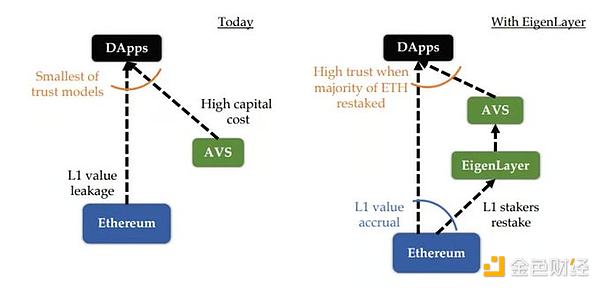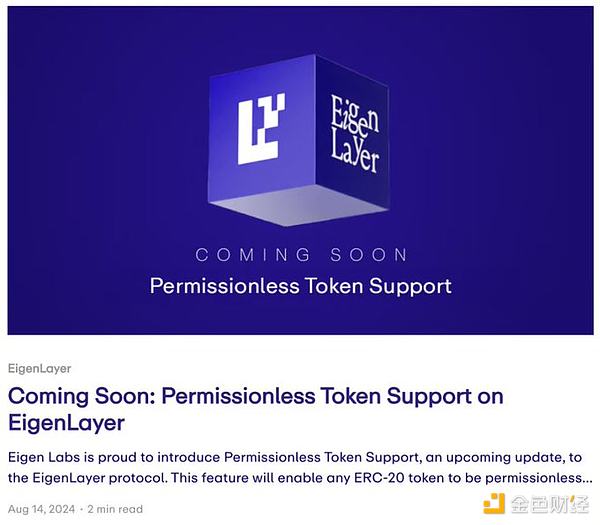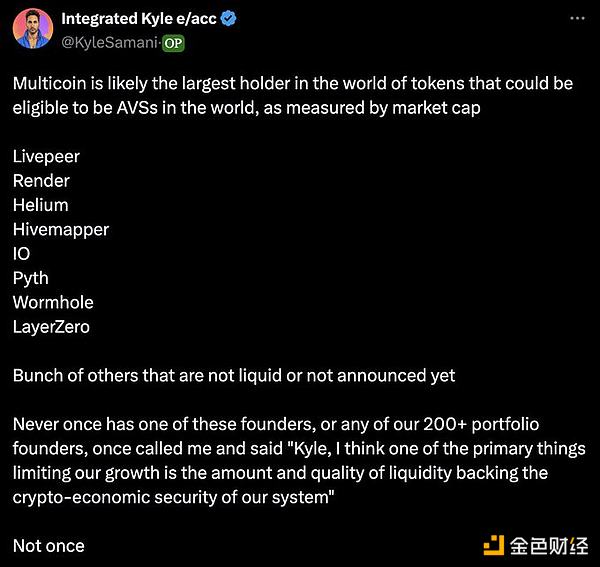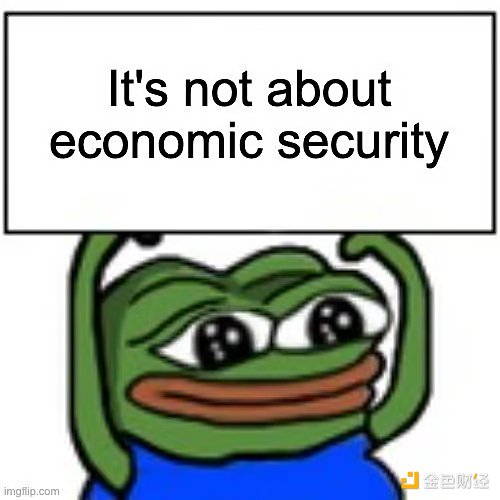Author: Marco Manoppo, Primitive Ventures; Translator: 0xxz@黄金财经
Note: Dovey Wan, founder of Primitive Ventures, commented on this article: My mental model of "restaking": Technically, it is similar to the PoS version of merged mining; economically, it is a smart way of rent-seeking on the chain; commercially, it is a regular arbitrage game that effectively serves as an ICO distribution for pre-release projects.
Recently, I have been thinking about the future of re-staking, as it has been the main factor driving the market over the past 18 months.
For simplicity, I may refer to EigenLayer or AVS when describing the broader concept of re-staking in this article, but I use the term to summarize all re-staking protocols and services built on them, not just specifically for EigenLayer.
EigenLayer and the concept of re-staking opens Pandora's box.
Conceptually, expanding the economic security of highly liquid and globally accessible assets is a good thing. It allows developers to build on-chain applications without launching a whole new ecosystem for their project-specific token.

Source: EigenLayer’s Whitepaper
The premise is ETH It is a blue chip asset that:
1. It makes sense for builders to use its economic security when building products, as it enhances security, reduces costs, and enables products to focus on their core functions.
2. Provides a superior product experience for end users
But 18 months after the EigenLayer whitepaper was released, the re-staking landscape has changed.
Now, we have Bitcoin re-staking projects such as Babylon, Solana re-staking projects such as Solayer, and multi-asset re-staking projects such as Karak and Symbiotic. Even EigenLayer has begun to promote permissionless token support, allowing any ERC-20 token to be added as a re-staking asset without permission.

Source: EigenLayer’s Blog
The market has signaled that all tokens will be re-pledged.
It’s no longer about extending the economic security of ETH. The real key to restaking lies in issuing a new type of on-chain derivative → the restaking token (and with it, the liquid restaking token).
Also, with the rise of liquid staking solutions, such as the Tally protocol, it’s clear that the future of restaking will span all crypto tokens, not just L1 assets. We’ll see stARB being restaking as rstARB, and now rstARB being wrapped as wrstARB.
So, what does this mean for the future of crypto? What happens when economic security can be extended from any token?
Restaking Supply and Demand Dynamics
Two factors determine the future of restaking.
In crypto, two things are always true:
1. People want more yield
2. Developers want to create tokens
People want more yield
From a supply side perspective, re-staking protocols have the best PMF.
We have learned from our Wall Street forefathers that crypto is quickly becoming a degenerate market that is constantly seeking more risk. An example? Event news derivatives markets are already on Polymarket.
The way re-stakers get more yield is due to services built on top of the re-staking protocol (AVS). In an ideal world, developers would choose to build on top of the re-staking protocol and incentivize re-stakers to allocate the re-staked assets to their projects. To do this, developers might share a portion of the revenue or provide rewards to re-stakers in the form of native tokens.
Let's do some simple math.
Data as of September 7, 2024.
Currently, $10.5 billion worth of ETH is being re-staked on EigenLayer.
Let's assume that most of this re-staked ETH is LST. Therefore, they are already generating 4% APY, and they want to earn more by re-staking.
To generate an additional 1% APY per year, EigenLayer and its AVS need to create $105 million in value. This is before slashing and smart contract risk.
Obviously, the r/r of re-staking is not worth it if it is just to increase APY by 1%. I would say it needs to at least double, around 8% more, for the risk to be worth it to capital allocators. This means the restaking ecosystem needs to create at least $420 million in value per year. Source: KelpDAO Currently, the huge returns we see from re-staking are sponsored by the upcoming EIGEN token and points programs for the liquidity re-staking protocol (examples above) - by comparison, the actual income returns (or projected income) are tiny.
Now imagine a scenario where there are 3 re-staking protocols, 10 liquidity re-staking protocols, and 50+ AVS. Liquidity will be fragmented; developers (in this case, consumers) will be burdened with the options they have, rather than having confidence in the options presented. Which re-staking protocols should I align with? Which assets should I choose to enhance the economic security of my project? And so on.
So either the amount of ETH being re-staking needs to increase dramatically, or we need the printing press (aka native token issuance) to go full throttle.
TLDR: Staking protocols and their AVS will need to put a lot of money in the form of tokens to keep the supply side alive.
Developers Want to Create Tokens
On the demand side, re-staking protocols believe that it is cheaper and safer for developers to use re-staking assets to support their applications, rather than using their own application-specific tokens.
While this may be true for some applications that require a lot of trust and security (such as bridges), the reality is that the ability to issue your own token and use it as an incentive mechanism is key to unlocking any crypto project, whether it is a chain or an application.
Using re-collateralized assets as a complementary feature of a product can provide additional benefits, but it should not guide the core value proposition of the product, nor should it be designed in a way that cannibalizes the value of your own token.
Some, such as Kyle from Multicoin, even take a harder stance and argue that economic security is not an important factor in driving product growth.

Honestly, his point is hard to refute.
I have been in the cryptocurrency industry for 7 years and I have never heard any of my friends in the industry who are advanced users of cryptocurrency and store most of their net worth on-chain tell me that he chose one product over another because of the economic security behind it.
From the economic side of things, Luca at M^0 wrote an excellent article explaining how it may even be cheaper for projects to use their native tokens than ETH due to market inefficiencies.
Wen tokens? Let’s face it, whether or not they are de facto securities, project specific tokens with some form of governance function, utility, economic or scarcity claim are viewed by investors as a proxy for the success or fame of the project. Even without any remaining financial or control claim, the market sentiment is the same. In an industry as small as crypto, tokens are often more tied to narrative or expected liquidity changes than cash flows. No matter how we look at it, it’s clear that the equity proxy market is far from efficient in crypto and how higher than reasonable token prices translate into lower than reasonably expected project capital costs. Lower capital costs often come in the form of lower dilution in venture rounds or higher valuations compared to other industries. It can be argued that native tokens are actually cheaper to build than ETH due to market inefficiencies across capital.
Source: Dirt Roads
To be fair, EigenLayer seems to have anticipated this scenario, as it designed its dual re-staking system. Now, its competitors are even using their marketing angle of supporting multi-asset re-staking as a differentiator.
If future re-staking means all tokens will be re-staked, then what is the real value of the re-staking protocol to developers?
I think the answer is insurance and enhancement.
The Future of Multi-Asset Re-staking: Fragmentation of Choice
If projects want to improve their products and differentiate themselves, then re-staking will become a complementary feature improvement for projects to integrate.
Insurance: It provides additional assurance that the product being offered will work as advertised because there is more capital underwriting it.
Enhancement: The best strategic move for a rehypothecation protocol is to reshape the entire narrative and convince the Builders that the default mode should include some element of rehypothecation technology in any product because it just makes everything better.
Oh, you’re an oracle that is vulnerable to price manipulation attacks? What if we are AVS too?
Whether end users care about this remains to be seen.
All tokens will compete to become the preferred rehypothecation asset because it gives them perceived value and reduces selling pressure. AVS will have multiple types of rehypothecation assets to choose from, depending on their risk appetite, incentive rewards, specific functionality, and the ecosystem alignment they want to have.
This is no longer about core economic security, it’s about insurance, rehypothecation, and politics.
What is still clear is that with all tokens being re-staked, AVS will have a lot of options.
Ultimately, this decision comes down to what provides the best functionality for my product. Just like applications are deployed on multiple chains and eventually become app chains, AVS will eventually leverage the economic security of the assets and ecosystems that benefit the most, and sometimes even more than one of them.
This tweet from Jai perfectly summarizes how most builders feel about re-staking returns.
We have already seen projects such as Nuffle working to address this problem.

Conclusion
Crypto Twitter likes to think in absolutes. The reality is that restaking will be an interesting fundamental concept that expands developer options and impacts on-chain markets by issuing a new type of derivative, but it is not the second coming of Jesus.
At the very least it allows crypto asset holders with a higher risk appetite to earn additional yield while expanding technology options and reducing engineering overhead for developers. It provides complementary functionality for developers and creates a new derivatives market for on-chain asset owners.
Many assets will be restaking, giving developers a lot of choices before deciding which restaking assets to integrate. Ultimately, developers will choose the restaking asset ecosystem that is most beneficial to their product, just as they would when deploying a new chain, and sometimes even multiple.
Tokens will compete for use as rehypothecation assets, as new derivative markets on rehypothecation assets will benefit tokens, giving them wider usability and perceived value.
This was never about economic security, it was about insurance, rehypothecation, and politics.

 JinseFinance
JinseFinance










